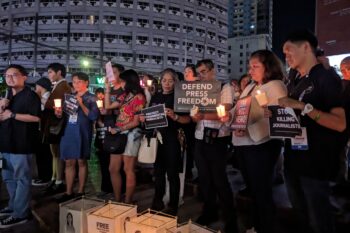GENERAL SANTOS CITY (MindaNews/19 July) – It was not the first time American soldiers were seen taking part in actual security activities of the Armed Forces of the Philippines or the Philippine National Police.
In the series of bombings in Southwestern Mindanao in 2007, American troops would arrive for post blast investigations.
These incidents include the deadly explosion in Tacurong City in Sultan Kudarat province on May 8, 2007, where three persons were killed and scores of others were injured, and the discovery of a “car bomb” in Surallah, South Cotabato on June 13, 2007.
While the ceasefire between government forces and the Moro Islamic Liberation Front (MILF) had been holding, US Special Forces continue to remain in the region, holding medical civic action programs (Medcaps), one of which was held in August last year in the remote coastal town of Palimbang in Sultan Kudarat.
Many of the US Special Forces roam around the region in civilian clothes, only to be identified as US troops once they board their “VFA” pick-up trucks.
“There were about 12 SF under the public affairs (office of the US military contingent) focusing on civil relation activities,” said 1Lt Ferdinand Ragos, commander of the 73rd Infantry Battalion’s Charlie Company.
Medcaps
The Charlie Company has jurisdiction over the towns of Maasim, Kiamba and Maitum (MaKiMa), and Palimbang in Sultan Kudarat.
Ragos told MindaNews his team joined hands with the US forces during the Medcap in Sitio Tineb, Barangay Mindupok in Maitum town in August 2011.
They, along with representatives from the provincial and local government units and other non-government organizations, conducted medical and dental services, operation tuli (circumcision), a feeding program, and shoes giving to children.
These US forces were the same personnel who also conducted Medcaps when Ragos was still assigned in Malapatan, Sarangani from 2009 to early 2011, he said.
“There were several instances of outreach missions in Malapatan by the US troops. They gave books and visited schools in Moro-dominated communities,” Ragos recalled.
He also said US troops conducted a Vetcap (veterinary civic program) in Palimbang, Sultan Kudarat, a Moro-dominated town.
Living in hotels
Curiously, the US troops preferred to stay outside the headquarters of local Philippine troops in Sarangani province.
“They lived in hotels in General Santos,” Ragos said.
One of the rest and recreation hideaways of the US troops is an upscale scuba diving resort in Maasim town, with a source saying they’re sometimes seen in the company of women.
Ragos said US troops teach local soldiers on high-tech or advance weaponry “several times” at the 73IB headquarters in Maasim town.
But critics maintain that part of the stay of US troops in the area is to gather intelligence data.
“Their Medcap is just a guise for intelligence gathering,” an official from Maitum, who requested anonymity, said, adding that the US presence in Mindanao “is also because of the rich mineral resources in the island.”
US Navy Rear Admiral Thomas F. Carney Jr., the US Naval head of delegation to the Cooperation Afloat Readiness and Training (CARAT) 2012, denied allegations of intelligence data gathering.
He told reporters on July 4 that the naval exercises between the American and Filipino troops in the seas of Mindanao was purely “to enhance interoperability and not to gather intelligence data” here.
Ryan Lariba, secretary general of the Bagong Alyansang Makabayan (Bayan) in the region, said the Philippines should be wary of the assistance extended by the US.
“The US is like a wolf posing as lamb. It pretends to be a friend when in fact it is a “well-disguised enemy. It will ‘help’ you on the one hand but kill you with the other,” he said.
Lariba cited as an example the recent CARAT 2012.
Economic
“They train the Philippine Navy, conduct civic missions, and what do they ask in return? Economic dictates through trade agreements that kill the Philippine economy and the Filipino people,” Lariba said in a statement.
He stressed that since CARAT exercises are also being done in other Asian countries, “this only means that the US is indeed strengthening its military hold in Asia and further control the economy and politics of the whole region.”
Notwithstanding the island’s richness, there were reports also that the US government is eyeing Sarangani Bay as another staging naval base in its Southeast Asia operations, also in line with Washington’s global war against terror.
Sarangani Bay’s natural harbor is believed to be suitable for the US naval fleet.
While US officials in CARAT 2012 did not say something about the bay’s natural docking capabilities, Gilberto Teodoro, Defense Secretary under the Arroyo administration, confirmed in 2009 the plan to build a Philippine Navy station in Maasim.
About four years ago, USS Blue Ridge sailed towards and docked at Sarangani Bay for civic and medical missions.
Modern gadgets
Within the jurisdiction of the 73IB, particularly in the MaKiMa area in Sarangani and in Palimbang, Sultan Kudarat, threat groups proliferate, according to 1Lt Rio Anthony Gammad, 73IB spokesperson and chief of its Civil Military Office.
In a briefing, Gammad identified the dominant threat group as the renegade MILF group, and on “various scales of danger,” the Jemaah Islamiyah, and private armed groups of local warlords.
Reports several years ago also indicated that the slain Abu Sayyaf chieftain, Khaddafi Janjalani, had used Palimbang as a hiding area.
Offshore, Gamad identified the security threats to fishermen as the “Ambak Pare,” a modus in which the armed men order those aboard to jump at the sea before taking their boats.
But with the different threats, there are modern surveillance gadgets now available in the area, courtesy of the US government, donated to the Philippine Navy.
These can be found in the Coast Watch Station, a Philippine Navy personnel said, pointing to a steel tower equipped with a radar and a telescope, built inside the headquarters of the 73IB in Maasim town. (Bong Sarmiento / MindaNews)
